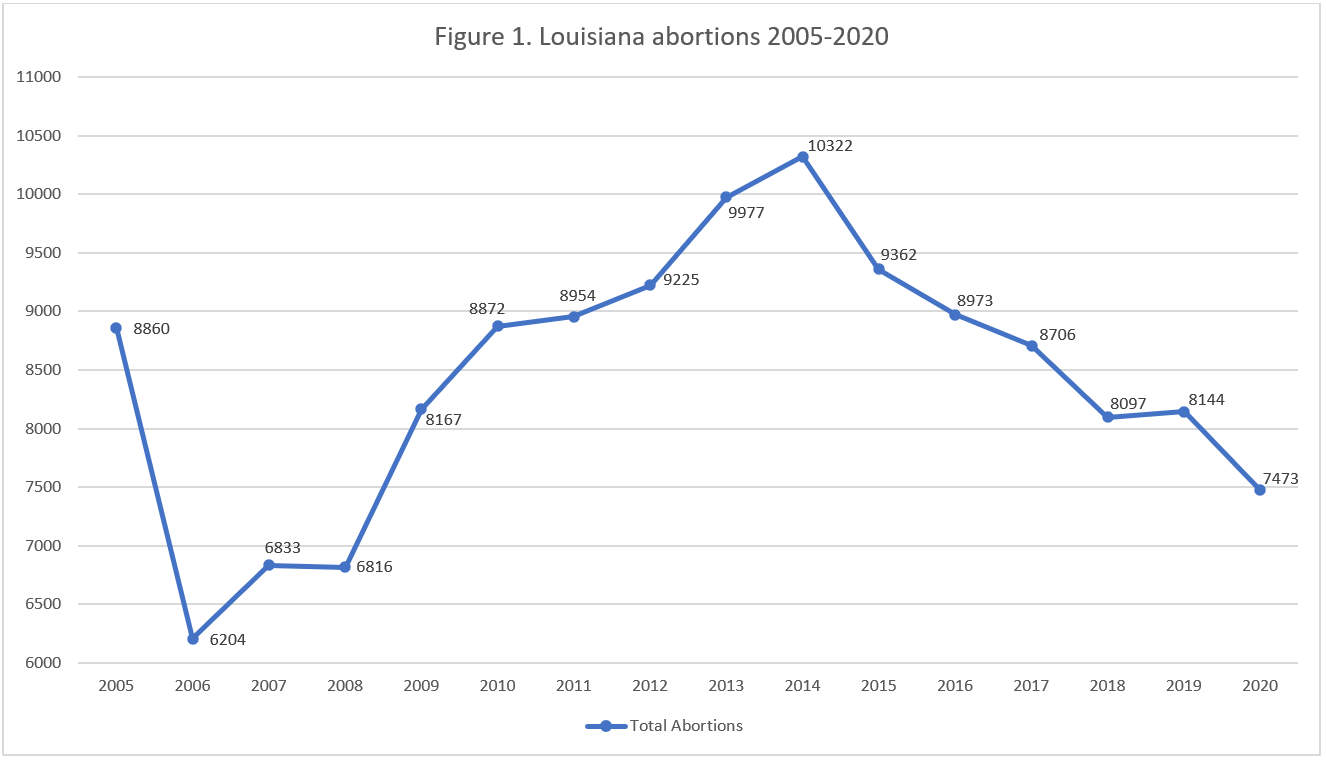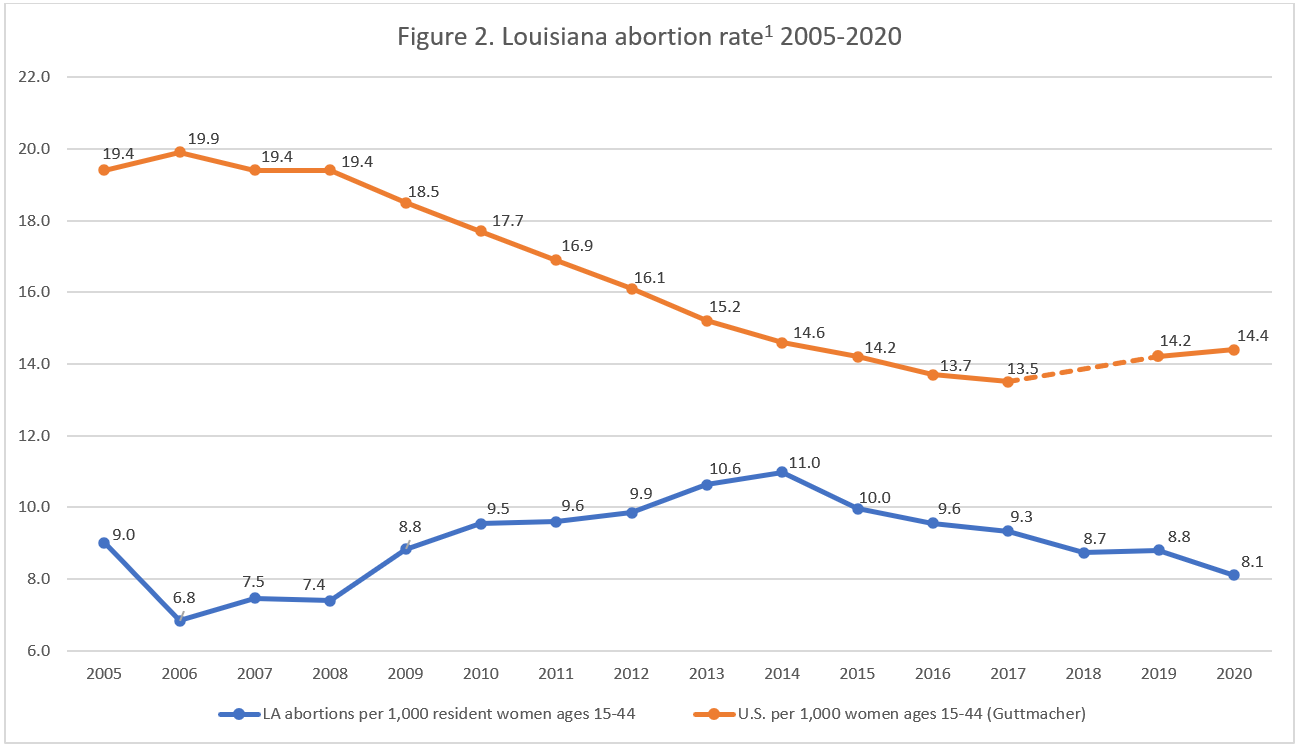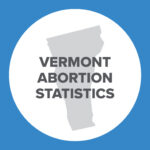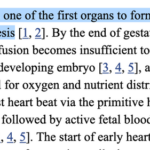Abortion Reporting: Louisiana (2020)
Louisiana’s 2020 abortion report was published by the Louisiana Department of Health in March 2022. The report shows that abortions declined from 2019.
Statistics and Changes in Louisiana Abortions, 2019-2020

Louisiana does not report the number of chemical abortions occurring in the state.
Abortion Totals and Trends
In 2020, there were 7,473 abortions reported in Louisiana, down eight percent from the previous year (Fig. 1). The Charlotte Lozier Institute (CLI) estimates that Louisiana’s 2020 abortion rate was 8.1 abortions per 1,000 women ages 15 to 44, a decrease of eight percent from 2019 and far lower than the national rate (Fig. 2). As of October 2022, 35 states had released 2020 abortion data, with 22 states reporting that abortions had decreased from 2019.
State Report Summary
The majority of Louisiana abortions occurred to women in their twenties, with 28 percent on women ages 20 to 24 and 30 percent on women ages 25 to 29. Another 30 percent occurred to women in their thirties, while nine percent of the abortions were performed on girls under the age of 20 and three percent were on women over the age of 40.
Sixty-five percent of the abortions reported in Louisiana were performed on black women. Twenty-four percent were on white women, and 10 percent were on women of other races. There were 35 abortions (0.5 percent) for which race was not reported. CLI estimates that Louisiana’s black abortion rate was 14.3 abortions per 1,000 women ages 15 to 44, over four times the white abortion rate of 3.3.
Most Louisiana abortions (89 percent) were performed on unmarried women. Nine percent were obtained by married women, and two percent were on women of unknown marital status.
A majority of the abortions reported in 2020, 61 percent, were conducted using suction curettage. Louisiana does not report chemical abortions separately, instead grouping them into a category of abortions performed using “other” procedures; “other” abortions accounted for 38 percent of the total. Dilation and evacuation abortions made up 1.5 percent of the total, while fewer than five sharp curettage and prostaglandin abortions were performed and the exact numbers were suppressed to protect confidentiality.
Sixty-four percent of the abortions performed in Louisiana occurred at eight weeks of gestation or earlier. Seventeen percent were performed between nine and 10 weeks, and eight percent were reported between 11 and 12 weeks of gestation. Five percent of Louisiana abortions were performed between 13 and 14 weeks of gestation, and four percent were reported between 15 and 16 weeks. One percent occurred between 17 and 19 weeks of gestation. Fewer than five abortions were performed at 20 weeks of gestation, although the exact number was suppressed.
Fourteen percent of Louisiana abortions were reported to have been performed for mental health reasons, while six percent were performed for the mother’s physical health. There were 28 abortions for rape or incest (0.4 percent) and 12 because of a risk of “fetal deformity” (0.2 percent). The majority of the abortions performed in Louisiana, 80 percent, were performed for other, unspecified reasons.
The Louisiana Department of Health provided CLI with information on the parish and abortion facility in which the abortions occurred. Almost half the abortions (49 percent) occurred at Hope Medical Group for Women. Twenty-nine percent were performed by Women’s Health Care Center, and 22 percent were performed by Delta Women’s Clinic. In addition to the 7,473 abortions reported in Louisiana, there were 388 abortions known to have been performed on Louisiana residents in other states. The report does not indicate where these abortions took place, and they are not included in any of the other tables in the report.
Protecting Life in Louisiana
The decrease in Louisiana abortions in 2020 was at least partially due to the state suspending elective procedures, including abortions, because of the Covid-19 pandemic. Further declines in abortions will likely be reported in 2022 and onward, now that the Supreme Court’s decision in Dobbs has enabled Louisiana to seek to enforce a law limiting abortion. While litigation on the matter continues, the law restricting abortions remains in effect. As of October 2022, the trigger law remains in effect while the courts review the law.
State Ranking
In CLI’s 2016 analysis of abortion reporting across the country, Louisiana was ranked at 10th best. Louisiana could improve its reporting by adding chemical abortion to its abortion reporting form. However, if Louisiana is able to enforce its law limiting abortion except when the mother’s life is in danger, very few abortions will be reported in the state. Louisiana could require that abortion providers submit a written explanation of why an emergency abortion was necessary, as in some other states. Louisiana could also require any medical professional treating an abortion complication to report these complications.


- Rates were calculated by CLI using the following formula: (total number of abortions performed in Louisiana ÷ number of resident women ages 15-44) x 1,000. Rates may differ slightly from previous CLI articles due to revised population estimates and abortion totals. Population estimates were obtained from the CDC WONDER database. Estimates for 2005-2009 are intercensal estimates of the July 1 resident population. Estimates for 2010-2020 are Vintage 2020 postcensal estimates of the July 1 resident population. Estimates were produced by the U.S. Census Bureau and the National Center for Health Statistics.

























